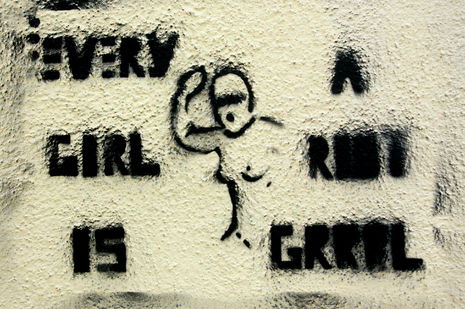Riot grrrl: Time for a Resurgence?
Columnist Maddy Fisher asks if it’s time for the movement to make a comeback

“When she talks, I hear the revolution” sing Bikini Kill in “Rebel Girl”, the pivotal song of Netflix’s new film Moxie. The film itself, which tracks the emergence of a feminist club and magazine in the recognisable American high school setting, has garnered rightful criticism. As with much so-called ‘intersectional’ media, its black, trans, and disabled characters are shoehorned in and are only there to assist the white female heroine in her journey towards radicalism. It was therefore not the weak message of Moxie that intrigued me, rather its focus on riot grrrl subculture as a means to inspire marginalised people today. Like with so many retro trends, is it time for this genre to make a comeback?
Riot grrrl was a feminist punk movement that emerged in the 1980s in the US as a response to the heavily male-dominated punk scene. The music is angry and uncompromising, exploring issues of sexual assault, heteronormativity, and idealised femininity. The genre was not just about the music, but the zines that politicised the private, and the safe community that was created at concerts and conventions. A declaration by Bikini Kill on the riot grrrl philosophy states ‘doing/reading/seeing/hearing cool things that validate and challenge us can help us gain the strength and sense of community that we need’. Personally, I have never quite felt safe at gigs where close contact is abused. My friends and I often queued early and got a place at the front of the crowd, yet by the end of the concert had been elbowed to the back. Experiencing live music as part of a supportive community with shared ideology thus seems an inviting prospect.
The movement was not without its problems, however. Many female-fronted acts with the occasional ‘angry’ lyric ended up being associated with it and, unfortunately, having your music labelled as ‘political’ often excludes it from serious discussions of musicianship. Furthermore, the movement mainly comprised of middle-class white women who had the means to protest and live off the meagre earnings of commissions. If Moxie was attempting to demonstrate this exclusionary element, then it (perhaps unwittingly) succeeded. Indeed, often forgotten in the discussion of riot grrrl is the formation of Sista Grrrl Riot, a safe space for alternative Black women punks who were alienated from both male punk and white riot grrrl. Women like Tamar-kali Brown and Maya Glick held their own New York shows, premised on the basis that ‘rock music is black music’. The neglect of this movement by most histories of riot grrrl is yet another example of the marginalisation of those on the intersections of inequalities.
“Radical feminist ideas have been replaced with a more marketable brand of individualist self-empowerment”
Could the radicalism of feminist punk, if re-directed towards marginalised women, have a place in music today? It would undoubtedly counter the current neoliberal brand of feminism. Radical feminist ideas have been replaced with a more marketable brand of individualist self-empowerment (think: ‘girl-boss’ and ‘choice’ feminism), which has translated into diluted feminist anthems. There is no denying my love of Dua Lipa and Taylor Swift (both of whom made some of the best albums of 2020), and they have certainly been subject to sexism in the music industry. Yet the ambiguous refrain of Dua’s ‘Boys will be Boys’ or the inward-looking focus of Taylor’s ‘The Man’ are not particularly radical anthems. Perhaps Taylor may have made it onto the Forbes 30 under 30 faster if she ‘were a man’, yet our focus should principally be on the unromantic struggles of the most oppressed women. This is near-impossible given record labels’ strict limitations on political expression, highlighting why much riot grrrl music was put out independently.
The artists that are spotlighting radical ideas today tend not to be from the guitar music genre that was so foundational to riot grrrl. Such artists and tracks include Noname’s “Rainforest” (about the illegitimacy of billionaires), collective SAULT’s music of Black struggle and joy, and the feminist and trans activism of Linn da Quebrada’s hip-hop and Latin funk infusion. Perhaps the remnants of landfill indie and saturation of middle-class guitar bands mean this genre is no longer a site for activism.
I’m not sure this is enough of a reason to completely reject riot grrrl philosophy, especially given the resurgence of online interest in it. At the time of writing, TikTok videos with #riotgrrrl have been viewed 56.3 million times. The desire for unfiltered music that expresses fury at the system is still present, not least in current bands like Big Joanie and Pussy Riot. The greatest relevance of riot grrrl however, is less its musical impact, rather the lessons it holds for feminism. To ensure that movements do not die out like it did, musicians and activists must not homogenise the experiences of women, and this key principle must inform all protest strategies and safe spaces. Without this firm commitment, riot grrrl must remain in the confines of the past.
 Interviews / You don’t need to peak at Cambridge, says Robin Harding31 December 2025
Interviews / You don’t need to peak at Cambridge, says Robin Harding31 December 2025 Comment / What happened to men at Cambridge?31 December 2025
Comment / What happened to men at Cambridge?31 December 2025 News / Unions protest handling of redundancies at Epidemiology Unit30 December 2025
News / Unions protest handling of redundancies at Epidemiology Unit30 December 2025 News / Varsity’s biggest stories of 202531 December 2025
News / Varsity’s biggest stories of 202531 December 2025 News / Downing investigates ‘mysterious’ underground burial vault 29 December 2025
News / Downing investigates ‘mysterious’ underground burial vault 29 December 2025









